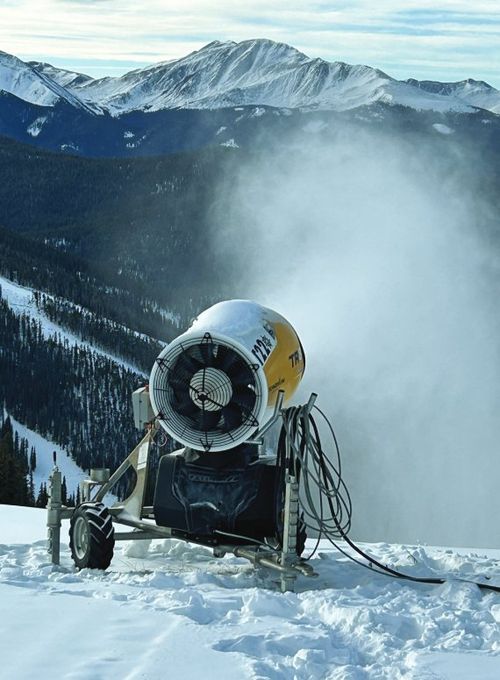KEYSTONE, Colo. -- The slopes at Keystone Resort hadn't yet opened for the day on the Friday before Thanksgiving as I stood atop Dercum Mountain, elevation 11,640 feet, and watched the ski area's extensive snowmaking operation in action.
Nearby, a mobile fan gun produced by Italy-based manufacturer TechnoAlpin sat at the top of the Mozart slope, where it was spraying water droplets downhill.
The air temperature, as displayed by the sophisticated machinery's internal weather station, was 32.9 degrees. But humidity of just 14% made the effective temperature for snowmaking purposes, a metric called the wet-bulb temperature, 21.7 degrees. Plenty cold enough to produce snow.
The sight of those water droplets crystallizing into snow had Keystone mountain operations directors Kate Schifani and Kolina Coe downright giddy.
"I could talk about snowmaking all day," Schifani said more than once over the course of the morning.
U.S. ski resorts have had snow guns blazing as they gear up for opening. Snowmaking teams are being recognized on social media feeds from Sugarloaf in Maine to Mammoth Mountain in California as resorts try to get visitors excited about sliding on snow.
And for good reason: Snowmaking technology can help ski areas lay down a base of snow so they can open sooner and stay open more reliably, thus extending the season and boosting profits. And tech advancements are helping resorts make snow faster, more economically and more sustainably.
Keystone has 672 fixed and mobile snowmaking guns, which it can deploy across approximately 40% of its 3,148 skiable acres. Extensive snowmaking provides Keystone, like many ski areas, with confidence that it can start its ski season each year within a reliable time frame, even in the face of climate change.

A Keystone mobile fan gun blows snow on a November morning. Photo Credit: Robert Silk
In 2019, Keystone improved its snowmaking operation with the deployment of 53 modern snowmaking machines and new water pipes along the 2-mile route that it opens first each season. Those improvements have helped the Vail Resorts-owned property push its average opening date since 2019 to Oct. 27, compared to a Nov. 8 average in the six prior years.
Keystone is now typically among the first Colorado mountains to open, along with nearby Loveland and Arapahoe Basin, and Wolf Creek in southern Colorado.
Like ski resorts around the world, Keystone is under the gun to make snow as sustainably as possible, especially in light of the industry's heavy exposure to the impact of climate change.
Schifani said that push-pull dynamic is ever present in the thinking of Keystone and Vail Resorts.
"With the advances in technology you can actually do more with less," she said. "We see that year over year we get better snowmaking, and it requires less resources and it makes pretty awesome snow."
Vail Resorts has especially ambitious climate goals. For the past two fiscal years, the company has netted 100% renewable electricity across its 37 North American resorts. In addition, Vail is targeting a net-zero operation by 2030, a metric that also incorporates items such as waste-to-landfill and on-site fossil fuel combustion.
For snowmaking, Vail properties such as Keystone, like many others in the industry, have turned to ever-improving automated equipment. During my morning visit to Keystone, we stopped into a midmountain operations center, where snowmaking controller Nick Daly sat in front of an interface displaying snowmaking locations. Sites occupied by automated, weather station-equipped snow guns displayed as green if conditions were ripe for snowmaking and red if they weren't.
Armed with such info, Daly could turn equipment on as soon as conditions reached the go zone and off as soon as conditions were no longer optimal. The machines are also capable of turning themselves on and off.
Coe explained that with automation, Keystone can turn on its snowmaking system in a matter of minutes, whereas it took two hours to dispatch staffers to stations without automation.
Automation helps the mountain make better use of its weather windows while reducing on-mountain fuel consumption by staffers. It also makes for much more consistent production of quality snow and in so doing, improves efficiency for both water and power usage.
Currently, approximately half of Keystone's snowmaking stations are automated, but improvements are ongoing. In 2023, the mountain added snowmaking capacity around its new Bergman Express lift, while also upgrading existing equipment in that part of the mountain.
Keystone doesn't have specific figures on the energy gains it has achieved through automation, but nearby Vail Mountain made efficiency gains of 85% from a 2019 project that included the addition of more than 400 automated snow guns and the laying of 19 miles of new pipe to bring its snowmaking operation higher on the mountain, Vail Resorts says.
For Keystone, and Vail Resorts more broadly, snowmaking upgrades are a pillar of a strategy to build a climate-resistant business, Schifani said.
"If we can ensure certainty around that October opening here at Keystone, our guests can expect that they're going to be able to ski, they're going to keep coming, we're going to grow our industry and it's a win for everybody," she said.